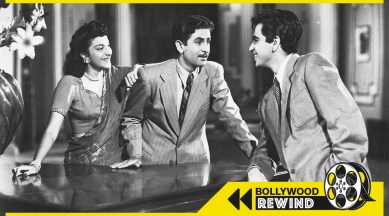Click here to follow Screen Digital on YouTube and stay updated with the latest from the world of cinema.

In over 100 years of Hindi cinema, we have possibly seen every version of a love triangle. But way back in the 1940s, the idea that a woman can share a platonic relationship with a man, which often becomes the base for such relationship dramas, was quite unheard of in the movies. So when Mehboob Khan made a film where a man misconstrued a woman’s friendship as her love, it was quite novel for the audience. The 1949 film Andaz, starring Dilip Kumar, Nargis and Raj Kapoor, had the three stars in a love triangle in possibly one of the biggest casting coups of the time.
The film follows Neena (Nargis), who develops a friendship with Dilip (Dilip Kumar) after he saves her life. Their budding friendship, which is shown almost like a budding love story, doesn’t get a stamp of approval from Neena’s father but Dilip is certain that theirs is the kind of love that will defy all odds. So when Neena introduces him to her fiance Rajan (Raj Kapoor), Dilip, along with the audience, is shocked. He finally confesses his love for her on her wedding day, but the film makes it seem like the onus for Dilip’s feelings is on Neena.
From this point on, the movie has Neena apologising to everyone for being friends with Dilip, and just feeling guilty over the fact that another man is in love with her, even though it’s not her fault. She has nothing to hide but she walks on eggshells around her husband, and he suspects that she is having an affair with Dilip.
Andaz pushes Neena into a corner where she has to be the one to prove her innocence when, as audience you can clearly see that she shouldn’t be the one taking the stand. At one point, Rajan violently attacks Dilip, almost killing him, but he walks away scot-free. Later, even Dilip attacks Neena, but the one who gets punished by the film, and the law here, is Neena.
The movie leaves no room for Neena to even ponder that she is innocent in this mess which makes you question if the 1940s society did not have a place for a platonic friendship between men and women, or the men making the movies just assumed that if a woman is being friendly, it has to mean that she is romantically interested. The latter still holds true for most mainstream Hindi movies where a woman’s politeness is often misconstrued as her willingness to be romantically involved.
Nargis’ character here is a well-educated woman, which was anyway an anomaly in the times that she was living in, so the decision to make her a free-thinking woman who makes friends despite the gender completely fits her character. What doesn’t work is her being sorry for another man’s decision to stay single because he once loved her. Even after Neena is a mother of a two-year-old, she is ashamed of being the object of someone else’s desire, even though she has completely distanced herself from him. It seems like the film is trying to say that a woman can be anything she wants to be as long as she is single. But once married, she belongs to her husband and the izzat of his khaandaan is solely on her shoulders.
It would be foolish to expect any kind of equality in a film that was made in the 1940s, but the idea that a woman would be blamed for any and everything has been so deeply ingrained in our society for so long that we’re still struggling to get out of it. Andaz is one of those films that doesn’t stand a chance today, at least in the way it was made back then because the way the filmmaker casually blames Neena for all her troubles wouldn’t fly today.
Click here to follow Screen Digital on YouTube and stay updated with the latest from the world of cinema.